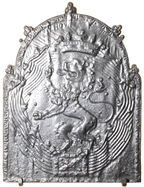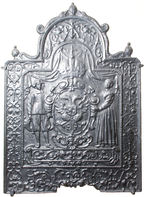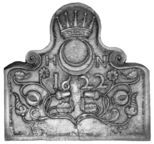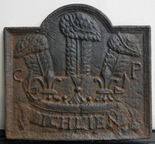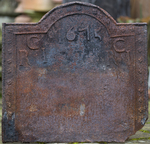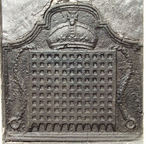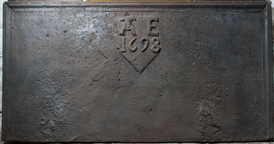-
566
Description: Arched rectangular central panel; bead-on-fillet edging; wickerwork Garden of Holland (Hollandse Tuin) within which is seated a berobed female figure holding a cap of freedom on the end of a long pole; before her is the crowned heraldic lion of the States General of the Netherlands, clutching a sheaf of arrows in its left front paw; above are the words, Pro Patria; arched rectangular border with cavetto-moulded edging, with the word, Hollandia, in the arch, suspended from which are festoons of flowers and fruit and the date within a scroll on the bottom; on top, a scallop shell between two mirrored serpents.
Notes: An overtly patriotic theme with symbols of Dutch nationhood.
Copies of this fireback are known.
Inscription: HOLLANDIA / PRO PATRIA / ANNO 1662
- Decoration tags:
- 'Dutch' (shape)
- cavetto (edging)
- whole carved pattern
- heraldic
- pictorial
- allegorical
- text
- humans
Manufactured: in 1662 in the Siegerland area of Germany.
Current location: Petworth House, Petworth, West Sussex, England.
Museum number: NT/PET/M/59 (part of the National Trust museum group)
- Attached to series:
- 'Dutch' Garden of Holland firebacks
-
580
Description: Arched rectangular shape with fillet edging and a repeated line and concentric semi-circle design; wicker enclosure with gate at bottom, overlaid with a lion rampant surmounted by a crown.
Notes: The enclosure is the Garden of Holland (Hollandse Tuin) and the lion the badge of the States General of the Netherlands; on the shoulders of the plate, and on three other positions equally spaced around the arch, repeated small fleurs-d-lys.
Inscription: ...E HOV...
- Decoration tags:
- rectangular with round arch (shape)
- complex individual (edging)
- whole carved pattern
- heraldic
- text
- animals
- objects
Manufactured: in the mid- to late-17th century possibly in the Siegerland area of Germany.
Current location: Petworth House, Petworth, West Sussex, England.
Museum number: NT/PET/M/71 (part of the National Trust museum group)
- Attached to series:
- 'Dutch' Miscellaneous Firebacks
- 'Dutch' Garden of Holland firebacks
-
542
Description: Arched rectangular central panel with canted top corners and bead-on-fillet edging; elaborate central cartouche containing the double-headed eagle of the Holy Roman Emperor supported by male and female figures standing on a compartment with fillet edging, containing scrolled foliage and a central fleur-d-lys; above the central cartouche, the imperial crown and swagged drapery; arched rectangular border with canted top corners and cavetto-moulded edging; symmetrical arrangement of traceried foliage; on top, central oval casket with a serpent descending on each side of the arch to a further similar casket on each shoulder of the plate.
Notes: A variation of the standard 'Dutch' style of fireback.
Manufactured: in the mid- to late-17th century possibly in the Siegerland area of Germany.
Current location: Petworth House, Petworth, West Sussex, England.
Museum number: NT/PET/M/97 (part of the National Trust museum group)
- Attached to series:
- 'Dutch' Miscellaneous Firebacks
- Foreign armorial firebacks
-
584
Description: Of unique design; quasi-arched rectangular shape; ribbon border, curled on each side of the neck. Symmetrical arrangement of plant tendrils with acorns, oak leaves, pomegranates and other leaves across the rectangular base; above and centrally placed are the date, over which are the initials either side of a crescent moon, surmounted by an earl’s coronet.
Notes: The initials, H N, are thought to refer to Henry, 9th Earl of Northumberland, and the date to his release from the Tower of London following his 17 years’ imprisonment for alleged involvement in the Gunpowder Plot.
Copies of this fireback are known.
Inscription: H N / 1622
- Decoration tags:
- rectangular with round arch (shape)
- complex individual (edging)
- whole carved pattern
- heraldic
- text
- plants
Manufactured: in 1622 probably at Frith Furnace, Northchapel in the Weald area of England.
Current location: Petworth House, Petworth, West Sussex, England.
Museum number: 485698 (part of the National Trust museum group)
- Attached to series:
- Personal firebacks
- Petworth lettering series
-
198
Description: Arched rectangular shape; cavetto-moulded edging; English royal coronet with three ostrich feathers rising from within; below, a motto scroll with inscription.
Notes: The badge of the Prince of Wales; the initials, CP, are probably for Carolus Princep; the motto is mis-spelled in error for 'Ich Dien' - I serve, which is more likely a mistranscription rather than a deliberate slur. The apparent crack in the angle of the arch and the top left of the fireback is an impression, indicating that this is a recasting.
Copies of this fireback are known.
Inscription: C P/ICH LIEN
- Decoration tags:
- rectangular with round arch (shape)
- cavetto (edging)
- whole carved pattern
- heraldic
- royal
- text
Manufactured: in the mid-17th century possibly in the Weald area of England.
Current location: not known.
- Attached to series:
- Prince of Wales firebacks
-
978
Description: Arched rectangular shape; twisted rope edging with inaccurately parallel arched rectangular fillet inside, enclosing repeated small fleur-de-lys stamps along sides and top; initials in triad in each of the internal top corners; date in arch.
Notes: The initials probably relate to a couple whose surname begins with C, the husband's forename initial being R and the wife's I (or J).
Inscription: RCI/ 1675 / RCI
- Decoration tags:
- rectangular with round arch (shape)
- rope (edging)
- simple stamps
- carved stamps
- individual letters
- individual numbers
- heraldic
- text
Manufactured: in 1675 in England.
Current location: not known.
- Attached to series:
- Date & initials firebacks
-
1248
Description: Central arched rectangular shape with rounded corners; ovolo moulding all round; oval Tudor royal shield with garter surrounding, topped with a royal crown; dragon and greyhound supporters; initials split by crown; all details below shield illegible; rectangular extension panels on each side, with twisted rope edging; quasi mirrored arrangement of twisted rope lengths to form (from the top) a cross, a vertical pointing arrow, and a diamond shape with a central vertical line.
Notes: The detail of the extension panel is sharper than the armorial, indicating that the panel was cast with a worn copy of the armorial. Illustrated in Weaver, 1914, p. 16.
Inscription: E R [+ Garter, Harvo and royal mottoes, all illegible]
Arms: Tudor royal (prob. Henry VIII)
- Decoration tags:
- rectangular with round arch (shape)
- rope and ovolo moulding (edging)
- simple stamps
- whole carved pattern
- extension panels
- heraldic
- apotropaic
- armorial
- royal
- text
- objects
Manufactured: in the late-16th to early-17th century in the Weald area of England.
Current location: in private hands, Plaistow, West Sussex, England.
Citation: Weaver, L., 1914, Small Country Houses: their repair and enlargement (London, Country Life).
- Attached to series:
- Pounsley series
- John Harvo series
- Tudor royal armorial firebacks
-
1191
Description: Rectangular; twisted rope edging (top and sides only); eight shields of Ayloffe impaling Sulyard in three rows, 3-2-3; Ayloffe: sable, a lion rampant Or, collared gules, between three crosses formy of the second; Sulyard: argent, a chevron gules between three pheons inverted sable.
Notes: William Ayloffe (c1535-1584) of Bretons, Hornchurch, Essex, Justice of the Court of Queen’s Bench, married (c1560) Jane, dau. of Sir Eustace Sulyard, of Runwell, Essex. Illustrated in Lloyd (1925).
Arms: Ayloffe impaling Sulyard (William Ayloffe of Bretons, Hornchurch)
- Decoration tags:
- rectangular (shape)
- rope (edging)
- carved stamps
- heraldic
- armorial
Manufactured: in the early-17th century in the Weald area of England.
Current location: not known.
Citation: Lloyd, N., 1925, 'Domestic Ironwork I', Architectural Review, 58, pp. 58-67.
- Attached to series:
- Ayloffe series
- Personal armorial firebacks
-
592
Description: Flattened arched rectangular shape with rebated concave shoulders; double fillet edging; 11 x 9 grid portcullis with symmetrical chains in ‘S’ arrangement ending in a ring, from top corners, surmounted by an arched royal crown.
Notes: Whole pattern; the portcullis has a realistic, rather than symbolic, appearance.
Copies of this fireback are known.
- Decoration tags:
- rectangular with canted top corners and round arch (shape)
- stepped fillet (edging)
- whole carved pattern
- heraldic
- pictorial
- objects
Manufactured: in the late-16th to early-17th century in England.
Current location: Ham House, Richmond, Surrey, England.
Museum number: 1140112 (part of the National Trust museum group)
- Attached to series:
- Miscellaneous royal firebacks
-
1096
Description: Rectangular shape; ogee/cyma reversa moulded edging (top and sides); top centre, shield-shaped stamp bearing initials above date.
Notes: Two blemishes on the surface of the casting indicate that the molten iron was probably poured from two ladles simultaneously disturbing the casting sand in both locations.
Inscription: AE / 1698
- Decoration tags:
- rectangular (shape)
- cyma reversa/ogee (edging)
- carved stamps
- date stamp
- heraldic
- text
Manufactured: in 1698 in the Weald area of England.
Current location: The Manor House, Mark Cross Lane, Ripe, East Sussex, England.
- Attached to series:
- Date & initials firebacks

